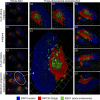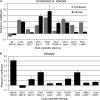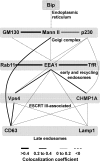Spatial relationships between markers for secretory and endosomal machinery in human cytomegalovirus-infected cells versus those in uninfected cells
- PMID: 21471245
- PMCID: PMC3126327
- DOI: 10.1128/JVI.00155-11
Spatial relationships between markers for secretory and endosomal machinery in human cytomegalovirus-infected cells versus those in uninfected cells
Abstract
Human cytomegalovirus (HCMV) induces extensive remodeling of the secretory apparatus to form the cytoplasmic virion assembly compartment (cVAC), where virion tegumentation and envelopment take place. We studied the structure of the cVAC by confocal microscopy to assess the three-dimensional distribution of proteins specifically associated with individual secretory organelles. In infected cells, early endosome antigen 1 (EEA1)-positive vesicles are concentrated at the center of the cVAC and, as previously seen, are distinct from structures visualized by markers for the endoplasmic reticulum, Golgi apparatus, and trans-Golgi network (TGN). EEA1-positive vesicles can be strongly associated with markers for recycling endosomes, to a lesser extent with markers associated with components of the endosomal sorting complex required for transport III (ESCRT III) machinery, and then with markers of late endosomes. In comparisons of uninfected and infected cells, we found significant changes in the structural associations and colocalization of organelle markers, as well as in net organelle volumes. These results provide new evidence that the HCMV-induced remodeling of the membrane transport apparatus involves much more than simple relocation and expansion of preexisting structures and are consistent with the hypothesis that the shift in identity of secretory organelles in HCMV-infected cells results in new functional profiles.
Figures








Similar articles
-
Three-dimensional structure of the human cytomegalovirus cytoplasmic virion assembly complex includes a reoriented secretory apparatus.J Virol. 2007 Nov;81(21):11861-9. doi: 10.1128/JVI.01077-07. Epub 2007 Aug 22. J Virol. 2007. PMID: 17715239 Free PMC article.
-
Identification of human cytomegalovirus genes important for biogenesis of the cytoplasmic virion assembly complex.J Virol. 2014 Aug;88(16):9086-99. doi: 10.1128/JVI.01141-14. Epub 2014 Jun 4. J Virol. 2014. PMID: 24899189 Free PMC article.
-
Envelopment of human cytomegalovirus occurs by budding into Golgi-derived vacuole compartments positive for gB, Rab 3, trans-golgi network 46, and mannosidase II.J Virol. 2003 Mar;77(5):3191-203. doi: 10.1128/jvi.77.5.3191-3203.2003. J Virol. 2003. PMID: 12584343 Free PMC article.
-
The link between the trans-Golgi network and tumour progression.Mol Biol Rep. 2025 Apr 28;52(1):435. doi: 10.1007/s11033-025-10548-6. Mol Biol Rep. 2025. PMID: 40293576 Free PMC article. Review.
-
Endosome-to-Golgi transport pathways in physiological processes.Histol Histopathol. 2011 Mar;26(3):395-408. doi: 10.14670/HH-26.395. Histol Histopathol. 2011. PMID: 21210352 Review.
Cited by
-
Mitochondria and Peroxisome Remodeling across Cytomegalovirus Infection Time Viewed through the Lens of Inter-ViSTA.Cell Rep. 2020 Jul 28;32(4):107943. doi: 10.1016/j.celrep.2020.107943. Cell Rep. 2020. PMID: 32726614 Free PMC article.
-
TRANSPIRE: A Computational Pipeline to Elucidate Intracellular Protein Movements from Spatial Proteomics Data Sets.J Am Soc Mass Spectrom. 2020 Jul 1;31(7):1422-1439. doi: 10.1021/jasms.0c00033. Epub 2020 May 29. J Am Soc Mass Spectrom. 2020. PMID: 32401031 Free PMC article.
-
An Overview on ERAP Roles in Infectious Diseases.Cells. 2020 Mar 14;9(3):720. doi: 10.3390/cells9030720. Cells. 2020. PMID: 32183384 Free PMC article. Review.
-
The effective multiplicity of infection for HCMV depends on the activity of the cellular 20S proteasome.J Virol. 2025 Jan 31;99(1):e0175124. doi: 10.1128/jvi.01751-24. Epub 2024 Dec 10. J Virol. 2025. PMID: 39655950 Free PMC article.
-
Modulation of Endosome Function, Vesicle Trafficking and Autophagy by Human Herpesviruses.Cells. 2021 Mar 4;10(3):542. doi: 10.3390/cells10030542. Cells. 2021. PMID: 33806291 Free PMC article. Review.
References
-
- Barr F. A., Short B. 2003. Golgins in the structure and dynamics of the Golgi apparatus. Curr. Opin. Cell Biol. 15:405–413 - PubMed
Publication types
MeSH terms
Substances
Grants and funding
LinkOut - more resources
Full Text Sources
Miscellaneous

